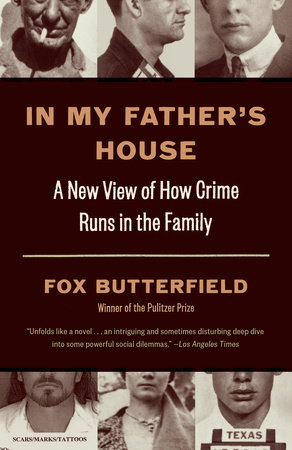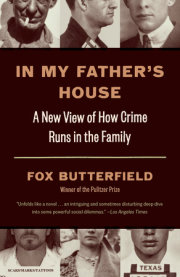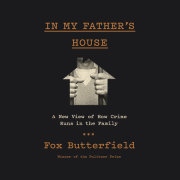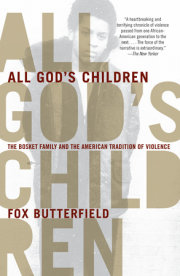***This excerpt is from an advance uncorrected copy proof***
Copyright © 2018 Fox Butterfield
Prologue
It Takes a Family to Raise a Criminal
The Oregon State Penitentiary sits incongruously in the middle of Salem, the state capital, next to a large park with fields for children’s soccer games and rows of residential streets. Armedguards patrol the twenty-five-foot-high concrete walls of the maximum-security prison. When the penitentiary was first constructed, in 1851, Oregon was not yet a state and Salem had only a handful of settlers who had trekked on foot over the Oregon Trail, so as the population of Salem increased, the city grew around the prison, making it a familiar sight. The neighborhood came to be known as Felony Flats.
For Bobby Bogle, who had been locked up most of the time since childhood, the location of the penitentiary seemed an apt metaphor for his life. For him and his brothers, prison and life ran together. Sitting on the steel bunk in his cell and thinking back on his childhood, Bobby could remember only one Christmas when his father gave him a present—a heavy metal wrench in a plain brown paper bag presented with no explanation. Bobby was just four years old at the time and for a moment was puzzled by the gift. But he knew from listening to excited conversations around the dinner table that his father, known to everyone by the nickname Rooster, had served hard time in a Texas prison for burglary and took pride in his criminal record. So Bobby figured his father had given him a burglar’s tool. Before dawn on Christmas day he snuck out of the house with his older brother, and they broke into the V & V Market, the little grocery store in the former migrant farmworkers camp where they lived on the edge of Salem. In the back of the store there were stacks of Coca-Cola bottles locked in a caged-in area. The wrench was big for Bobby’s small hands, so he worked awkwardly as he used his present to break open the lock on the cage. Then the boys carried home their sodas for a Christmas celebration.
Rooster was elated. “Yeah, that’s my sons,” Bobby could still recall his father saying, years later, as if celebrating a school report card with straight A’s or a Little League home run. “My father had been encouraging us to steal practically since I was born,” Bobby told me. We were seated face-to-face in the penitentiary’s visitors’ room, where I was interviewing Bobby for an article I was writing for The New York Times as part of my beat covering criminal justice. “He taught us stealing was good, as long as we didn’t get caught,” Bobby added. “If we got caught, he would use the knife he always carried to cut off a tree branch to make a switch and then whup us till we were cut and bleeding.” Bobby took the lesson to heart. In the Bogle family, crime brought respect. “So I wanted to go to prison from the time I was a young boy,” Bobby explained, “to uphold our family honor and earn my stripes.”
Bobby was wearing the standard-issue uniform for all Oregon inmates: dark blue denim pants and a lighter blue work shirt, both emblazoned in fierce orange letters with the label “Inmate, Oregon Department of Corrections.” Bobby had been locked up almost continuously since he was around twelve years old, first in juvenile reformatories and later in a series of prisons. With all that incarceration, he had the cold-eyed convict look down. Bobby was short, five feet nine inches, but all the weight lifting he had done in prison yards for so many years made him look taller. His broad shoulders and thick chest seemed to belong to a much bigger man. His jaw was square, and his green eyes were always alert, on the lookout, as he had to be for self-preservation in prison. His salt- and-pepper hair was brushed back from his forehead and cut short on the sides. The gun fighter mustache drooping down around the corners of his mouth lent him an air of menace.
For Bobby and his five brothers and three sisters, childhood often meant accompanying their father, and their mother, Kathy, whenever Rooster selected targets for them to rob or burglarize. There were neighbors’ houses to break into, chickens and cows to steal for food, gardens to loot for tomatoes and corn, and construction sites where they could pluck valuable lumber or metal that Rooster resold for cash to supplement his on-again, off-again job as an ironworker. One night Rooster led them to the Bonneville Dam on the Columbia River, ninety miles northeast of Salem, where they broke into the government-run fish hatchery and helped themselves to as many coho and Chinook salmon as they could load into Rooster’s truck, later eating as much as they could and selling the rest to neighbors. Their mother served as the lookout, remaining in the truck while they were inside the fence, and then she drove the getaway vehicle.
One of Bobby’s younger brothers, Tracey, recalled this period as a good time of madcap family adventure. Tracey Bogle was seven years younger than Bobby and was also locked up in the Oregon State Penitentiary. “We did it all as a family,” Tracey said in a separate interview in the visitors’ room. “We had pride in our family doing these robberies, so it was fun. We were a crime family.”
Perhaps with more insight than he was aware of, Tracey observed, “What you are raised with, you grow to become.” Despite a diagnosis of paranoid schizophrenia, Tracey was often the most articulate and analytical member of his family. “If I’d been raised in a family of doctors, I’d probably be a doctor. But I was raised in a family of outlaws who hated the law.” His words made him sound like he was pronouncing an epitaph for his family. “The only law I knew was cops coming to arrest me or my brothers, breaking down our doors and taking me to court.”
One of the happiest moments of his life occurred when Tracey was eight years old. He and Bobby managed to sneak into the attic of a bar one evening. They hid there until after closing time, then climbed back down the stairs into the deserted, darkened barroom and helped themselves to all the money in the cash register. They walked home to the trailer they were sharing with their mother at the time and dumped a sack of bills on her head. That woke her up and made her shriek with joy. Just telling the story made Tracey happy. He laughed so hard that tears rolled down his cheeks and his body shook with pleasure. It was as if he had somehow been transported beyond the high prison walls and the barbed-wire fence surrounding them and also transported back in time to that very moment in his mother’s mobile home. This was his childhood, the only one he knew, so it was fun even when it was painful.
As the boys grew older, they all dropped out of school. Bobby left in the seventh grade, and Tracey in the eighth grade. Instead of attending conventional commencement ceremonies, they graduated to more serious crimes. Their favorite was stealing big-rig trucks, eighteen-wheelers running south from Salem in the Willamette Valley to California on Interstate 5, a drive of 300 miles, or from Salem east to Boise, Idaho, on Interstate 84, a distance of 475 miles. When they started these capers, Tracey was so young and short that he could barely see over the steering wheel and his feet hardly reached the pedals. Semis were more valuable than cars, the boys calculated, because they carried much more gas and could go farther. One time they stole a semi from a truck parking lot in Salem and rammed it into the side of a gun store, right through the wall, and made off with a haul of guns. Another semi they stole was loaded with $100,000 worth of liquid sugar. That landed them in court, and they were both sent to the MacLaren School for Boys, Oregon’s most secure juvenile facility, just off the highway between Salem and Portland. The brothers like to think they must have stolen three hundred semis altogether. Even allowing for youthful braggadocio, the number was probably large.
I first heard about the Bogles in 2002 from Steve Ickes, then an assistant director of the Oregon Department of Corrections. At the time, his office thought there were six members of the Bogle family who were in prison or had earlier been incarcerated. Steve arranged for me to interview a few of them behind bars, including Bobby and Tracey. I had previously written a book about four generations of outlaws, thieves and murderers in a black family, All God’s Children: The Bosket Family and the American Tradition of Violence, and I was struck by a recent series of studies showing that crime seemed to run in certain families. I hoped to find a white family with a sizable number of inmates to illustrate this perverse legacy while removing race as a factor in the discussion. The Bogles seemed like a candidate.
Now, after ten years of research, I have found sixty Bogles who have been sentenced to either prison, jail or a juvenile reformatory, or placed on probation or parole—in other words, put under the supervision of the criminal justice system. These are only the ones for whom I could find official court, prison or police records. More than likely, the actual total is higher. Over the passage of years, court files often get lost or stored in some forgotten warehouse: in other cases, Bogle family women who went to jail may have used their married names and therefore are untraceable. Or, they may have had children who were sentenced to prison under the name of a husband or boyfriend whom I could not identify.
The figure of sixty might appear to be an outlier, some oddity out of Ripley’s Believe It or Not. But the Bogles are something much more important, and commonplace—a dramatic example of findings by criminologists from around the United States and other countries that as little as 5 percent of families account for half of all crime, and that 10 percent of families account for two-thirds of all crime. Perhaps the most important of these studies was conducted on a group of 411 boys from South London, England, following them from 1961 to 2001, by a team of British criminologists led by David Farrington of the University of Cambridge. Half of all the convictions of these boys were accounted for by a mere 6 percent of the families in the sample; 10 percent of the families accounted for two-thirds of all convictions. The longitudinal study, known as the Cambridge Study in Delinquent Development, also showed that having a father or mother who had been convicted, or an older brother or sister who had been convicted, was a good predictor of a boy’s later criminal activity. Having a parent who had not only been convicted but was then sent to prison was an even stronger predictor of a boy’s later criminal life.
A similar concentration of criminality was found in large, multiyear studies of delinquent boys in Philadelphia, Pittsburgh and Rochester by American criminologists. Another measure of how strongly crime runs in families comes from the Justice Department’s Bureau of Justice Statistics. It has reported that roughly half of the 2.3 million Americans in jail or prison have a father, mother or other close family member, like a brother, sister or uncle, who has previously been incarcerated.
What criminologists call the intergenerational transmission of violence was first documented in a pioneering longitudinal study of five hundred delinquent boys in the Boston area in the 1940s by a husband-and-wife team of researchers at the Harvard Law School, Sheldon and Eleanor Glueck. The Gluecks found that two-thirds of the boys sent by a court to a reformatory had a father who had been arrested and half had a grandfather who had been arrested. Forty-five percent also had a mother who had been arrested.
Equally striking, all the delinquent boys in the Gluecks’ study were white. In part, this racial makeup is a reminder that until the 1960s, at least, until the Second Great Migration of blacks from the South after World War II, most crime, including violent crime, was committed by whites. Our best-known outlaws until then were white: Jesse James in Missouri in the nineteenth century, Al Capone in Prohibition-era Chicago and Bonnie and Clyde in Texas during the Depression. They tended to be rural, white and poor, or ethnic white immigrants: Irish, Italians or Poles who belonged to gangs in this country’s big cities. The common American stereotype today of young black predators with guns dealing drugs was a creation of more recent years, starting in the 1960s.
Michael Harrington, the social worker and Socialist Party leader, captured the spirit of the Southern rural, white poor who had moved into the big cities during the Depression or in World War II in search of jobs in his 1962 best seller, The Other America: Poverty in the United States. He called them “urban hillbillies,” at a time before political correctness. “They are in the slums,” Harrington wrote, using another term that has fallen out of favor. “They came up from the Appalachians to Detroit for war jobs, and stayed on. . . . They can be identified by their ninth-generation Anglo-Saxon faces, by their accents, and by the ubiquity of country music. . . . One could read the fates written on some of the children’s faces. It was relatively easy to guess which boys might end up in a penitentiary, which girls would become pregnant before they were out of grade school.”
The Bogles are a carryover from this older America, when crime was largely a phenomenon of disadvantaged whites. By examining what happened in their family, how they passed a malignant heritage of criminality on to their children and grandchildren and even great-grandchildren, it might be possible to get around race when thinking about the causes of crime, to disentangle race and crime and overcome one of our most deep-seated stereotypes. This is not meant to downplay the terrible racial disparity that arose as the war on drugs and the accompanying movement to toughen our sentencing laws resulted in a quadrupling of the U.S. prison population from the 1970s until it declined modestly in the past few years. This experiment with mass incarceration has given the United States the terrible distinction of having the highest rate of imprisonment in the world along with a racially skewed prison population. In 2014, the Justice Department reported that 6 percent of all black men age thirty to thirty-nine were in prison; the rate for Hispanic men the same age was 2 percent, and it was 1 percent for white men in that age group. It is also important to note that even now, if property crimes are included with violent crimes, 69 percent of all crimes reported to the police are committed by whites, according to the Uniform Crime Report, published annually by the FBI.
As I spent more time listening to the Bogles’ stories and learning how many of them ended up with criminal records, I realized the Bogles also offered a way to refocus on the family as a cause of crime. Oddly, many criminologists have neglected this aspect of criminality in recent years, looking instead at such well-known risk factors as poverty, bad neighborhoods, deviant peers at school, drugs and gangs. These are real issues. But chronologically, a child’s life and development begin at home with his or her family even before their neighborhood or friends or classmates can influence them. John Laub, a professor of criminology and criminal justice at the University of Maryland and one of the leading American criminologists, has suggested that scholars have avoided focusing on the family because the very mention of family suggests a possible biological or genetic basis for crime that could lead to charges of racism.
Tracey Bogle, though, had no such compunctions in trying to analyze his own descent into a criminal career. “Once you get in it, it is a really strong pull,” he told me in another prison interview. “Sometimes I think it was the power of imitation, copying the behavior of my father and older brothers and uncles.” Without realizing it, Tracey had stumbled into one of the main schools of criminology, known as “social learning theory,” which holds that young criminals develop by imitating behavior they see around them through the same psychological process as any other behavior is learned. Tracey had never graduated from high school, much less studied criminology, so it was sufficient for him to repeat his family’s view of how they became ensnared in criminal lives. “We just call it a curse, the Bogle curse,” Tracey said. Both Tracey and Bobby and their brothers and cousins had come to believe that crime starts at home. They learned everything they needed to learn in their father’s house. In other words, it takes a family to raise a criminal. And here lies the central thesis of this book: we talk about the importance of family values, and in doing so we tend to assume that these values are good, but family values can go off track and be bad, and the results, over generations, can be devastating.
As the criminal paterfamilias, Rooster Bogle not only took his children out to commit crimes with him; he even happily prophesied where this would lead them. Some days he would take his boys to a lake southeast of Salem to go fishing, their route taking them past another sprawling prison, the Oregon State Correctional Institution, which was surrounded by mounds of shiny razor wire. Rooster would gaze at the facility with something akin to a perverse nostalgia, as if he were looking at a great castle. On these occasions he liked to tell his oldest son, Tony, “Look carefully, because when you grow up, you guys are going to end up there.” Tony took this not as a warning but as a challenge. Far from imposing and terrifying, the place looked downright inviting to Tony. He would look up at the guard towers and say to his father, “Let’s go there right now.” Later Tony made his father’s prognostication come true, albeit in a different state and a different prison. In 1991, at the age of twenty-nine, he murdered a man in Tucson, Arizona, and was sentenced to life in prison. He is still there.
Bobby, Tracey and Tony had no idea about the total number of Bogles who have been sentenced to prison, or about when their family’s ruinous criminal history began. “The past was kept back from us,” Tracey said. “It was a secret.” As boys, the only thing they knew were the stories Rooster told them. He traced the family history to his mother, Elvie, who he said was a gypsy from Germany who migrated to Texas. Not just any gypsy, Rooster told them, but the queen of the gypsies who worked in a carnival, sold moonshine and befriended Bonnie and Clyde during the Depression. “My dad said gypsies lived by stealing, so we would steal,” Tracey recalled. Rooster personally gave each of his eight children what he said were gypsy tattoos, little blue dots under their left eyes.
But even what little the brothers thought they knew about their family, the stories their father told them, often were not true, and none of their older relatives who knew more, their aunts and uncles, their grandfather and grandmother, corrected Rooster’s version. It was only years later, after the boys grew old enough to be sent to prison, that they learned the blue dots on their left cheeks were a mark convicts in state and federal prison in the 1950s and 1960s gave themselves so they could identify one another after they were released. Richard Hickock and Perry Smith, the two ex-convicts who murdered the Clutter family on their farm in Kansas, as recounted by Truman Capote in his best seller In Cold Blood, had the marks. It was another of Rooster’s ways of branding his children and leading them to a long criminal doom. Oddly, one thing that no one in the family seemed to know was the origin of their name, Bogle; it is a Scottish word, meaning a goblin that, on behalf of the victims, sometimes causes mischief to those who have committed crimes.
Bobby, Tracey and Tony have each been incarcerated most of their adult lives. They had no way to track down their lost family history, so they urged me to find out what I could. Perhaps by going back in time, back into the Bogle family’s memories, its myths, its brutalities, it might be possible to learn when all this began and how the criminal virus was transmitted. When we first discussed attempting this research, none of us knew that the Bogles could be traced to the hills of Tennessee during the Civil War or to a poor cotton sharecropper’s farm near Paris, Texas, in 1920. This is their family story.
. All rights reserved. No part of this excerpt may be reproduced or reprinted without permission in writing from the publisher.







